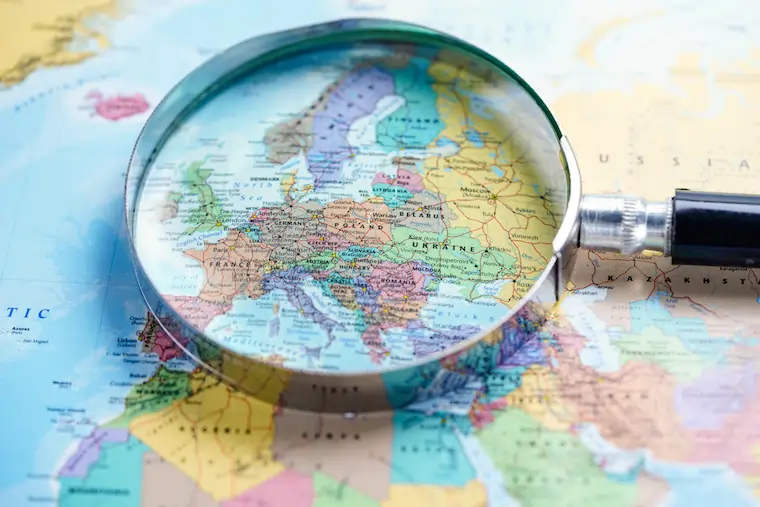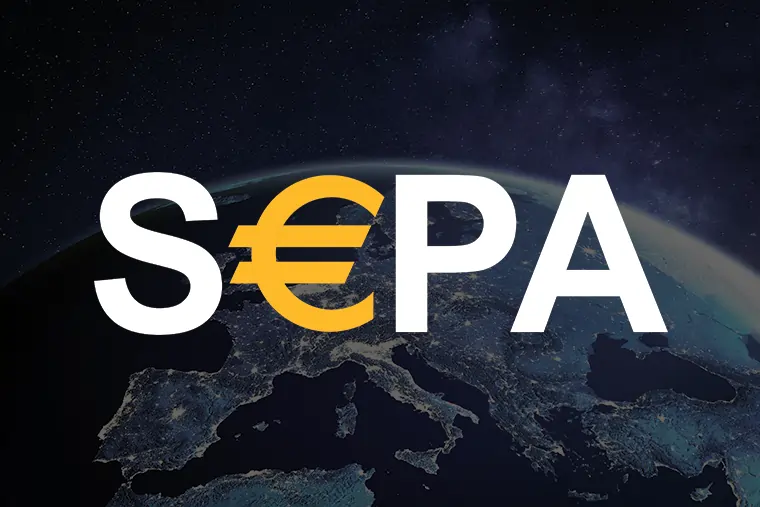SEPA countries belong to one of the most important international networks globally, the Single Euro Payments Area (SEPA).
Additionally, this list of countries is a powerful tool for anyone seeking international banking solutions, specifically how to open a bank account in Europe as a non-resident.
KEY TAKEAWAYS
- Non-resident individuals and foreign business owners can benefit from opening accounts and sending euro transactions between SEPA jurisdictions
- Requirements for opening accounts will vary depending on the country you choose to open with
- Non-residents can unlock low-cost and fast euro payments
- There are also 17 lesser-known SEPA jurisdictions, in addition to the 36 well-known jurisdictions
An important point is that knowing which SEPA jurisdictions exist isn’t enough to successfully open accounts. This is especially true if you’re a non-resident, a non-European citizen, or you’re looking to open accounts outside of your home country.
In this article, we’ll share everything you need in order to choose the right jurisdiction for you. Plus, we’ll also help you get started with opening accounts so you can reap all the benefits of SEPA transfers.
Before diving in, if this is your first time visiting GlobalBanks, don’t forget to download your FREE Non-Resident Banking Starter Guide. It’s designed to help non-residents open an international bank account in top banking hubs around the world.
To quickly navigate through this article, please use the following table of contents to jump ahead to whichever section is most relevant to you.
Table of Contents
- Single Euro Payments Area [Country List]
- Breakdown of all SEPA Countries
- What is a SEPA Bank Transfer?
- What Are the Benefits of Opening a Bank Account in a SEPA Country?
- Can a Virtual Bank Account Connect to SEPA?
- How to Open Bank Accounts in a SEPA Country
- Secret SEPA Countries & Territories
- Which Country Should You Bank In?
- Frequently Asked Questions
- Ready to Unlock the Benefits of International Banking?
Single Euro Payments Area [Country List]
As of September 2022, the SEPA countries list has 36 member-states: Andorra, Austria, Belgium, Bulgaria, Cyprus, Croatia, Czech Republic, Denmark, Estonia, Finland, France, Germany, Gibraltar, Greece, Hungary, Iceland, Ireland, Italy, Latvia, Liechtenstein, Lithuania, Luxembourg, Malta, Monaco, Netherlands, Norway, Poland, Portugal, Romania, San Marino, Slovenia, Slovakia, Spain, Sweden, Switzerland, United Kingdom, and the Vatican City State.
* Last updated by the European Central Bank on October 30th, 2020
As you can see, the SEPA network includes many of the most popular jurisdictions for account opening in Europe. Plus, there are a few secret offshore jurisdictions (listed below) that also connect to SEPA.
Having an account in one of the 36 jurisdictions above means being able to send and receive payments fast and affordably through more than 5,900 banks.
We break this list down for you even further below.
Breakdown of SEPA Area Countries
The table below shares each of the principal SEPA jurisdictions. Additionally, we share their IBAN/BIC code, currency, and status within the EU, EEA, or EFTA. That said, later in the article, we’ll share the secret jurisdictions that you may not have heard of. Of course, if you have any questions about opening accounts in these jurisdictions, we’d love to hear from you.
| SEPA Countries | IBAN Code | Currency | Affiliation |
|---|---|---|---|
| Andorra | AD | EUR | Non-EU |
| Austria | AT | EUR | EU |
| Belgium | BE | EUR | EU |
| Bulgaria | BG | BGN | EU |
| Croatia | HR | HRK | EU |
| Cyprus | CY | EUR | EU |
| Czech Republic | CZ | CZK | EU |
| Denmark | DK | DKK | EU |
| Estonia | EE | EUR | EU |
| Finland | FI | EUR | EU |
| France | FR | EUR | EU |
| Germany | DE | EUR | EU |
| Gibraltar | GI | GIP | Non-EU |
| Greece | GR | EUR | EU |
| Hungary | HU | HUF | EU |
| Iceland | IS | ISK | EEA |
| Ireland | IE | EUR | EU |
| Italy | IT | EUR | EU |
| Latvia | LV | EUR | EU |
| Liechtenstein | LI | CHF | EFTA |
| Lithuania | LT | EUR | EU |
| Luxembourg | LU | EUR | EU |
| Malta | MT | EUR | EU |
| Monaco | MC | EUR | Non-EU |
| Netherlands | NL | EUR | EU |
| Norway | NO | NOK | EEA |
| Poland | PL | PLN | EU |
| Portugal | PL | EUR | EU |
| Romania | RO | RON | EU |
| San Marino | SM | EUR | Non-EU |
| Slovakia | SK | EUR | EU |
| Slovenia | SI | EUR | EU |
| Spain | ES | EUR | EU |
| Sweden | SE | SEK | EU |
| Switzerland | CH | CHF | EFTA |
| United Kingdom | UK | GBP | Non-EU |
| Vatican City State | VA | EUR | Non-EU |
What Is a SEPA Bank Transfer?
When sending payments and transfers between banks located in the above-mentioned jurisdictions, the sender is automatically engaging in a SEPA transfer. In other words, any payments that are sent between SEPA jurisdictions automatically benefit from faster transfer time and dramatically lower costs.
Now, you might be wondering: how long does it actually take for a payment to arrive? Well, the answer is, it depends.
Transfers and payments that are sent electronically between SEPA banks should take no longer than 24 hours. However, customers also have the option to use paper transfers. If you choose to forgo electronic transfers and file a paper transfer instead, you should expect the transfer to take at least 48 hours.
Obviously, given that SEPA is short for Single Euro Payments Area, you should only consider opening accounts in SEPA jurisdictions if you have a genuine need for euro transactions. Of course, there are endless reasons why one might have such a need. But, if that’s not you, there may be better options available elsewhere.
What Are the Benefits of Opening a Bank Account in a SEPA Country?

We’ve already touched on the economic benefits of opening accounts in these jurisdictions, such as fast and affordable payment transfers. But there are other benefits to tap into as well.
In fact, regardless if you’re an individual, a business owner, or have a wealth planning structure like a trust or foundation, an account in one of these jurisdictions can offer additional advantages.
Let’s take a quick look at some of the top benefits that non-residents and foreigners can capture when opening accounts in a SEPA jurisdiction…
- Access to the European banking system as an individual or foreign and non-resident entity
- Low-cost and fast payments in EU countries (and elsewhere)
- English language and customer support in some jurisdictions
- Full range of products and services including retail, commercial, and private accounts
- Online and remote opening is still possible in some jurisdictions
- SEPA-area countries are not considered offshore jurisdictions or tax havens
- Access to a single currency without currency conversion fees
Can a Virtual Bank Account Connect to SEPA?

In certain SEPA jurisdictions, online and remote opening is still possible. This is true whether you are opening accounts with brick-and-mortar banks or virtual banks. And, this is even true for non-residents who are not European citizens. Additionally, in certain instances, non-residents can open accounts with limited restrictions. For example, individuals can open European accounts, specifically a UK bank account without proof of address. non-residents to open UK accounts without proof of address.
GlobalBanks members can open SEPA accounts with as little as 300 euros from the comfort of their home, from pretty much any country in the world. So, if you’re already a GlobalBanks member and you’re interested in this, just send us a request from your Dashboard and we’d be happy to help you start opening accounts.
Of course, if you’re not already a GlobalBanks member, you can use the information shared below to decide which country is best for you. Additionally, by accessing our detailed articles (linked below), you can also identify which jurisdictions might meet your opening requirements.
Of course, given that most of the jurisdictions are members of the EU, there are some similarities when it comes to opening accounts. So, before deciding which jurisdictions are best for you, let’s look at some of the opening trends you should be aware of.
How to Open Bank Accounts in a SEPA Country

The exact steps to opening accounts in these jurisdictions, including opening a bank account in Denmark, Malta, or Portugal will depend on the country chosen. But generally speaking, the following considerations are relatively consistent across all jurisdictions and should be examined more closely on a country-by-country (and bank-to-bank) basis before deciding where to open.
Required European Connection
If you’re a non-EEA citizen, opening accounts in SEPA jurisdictions will require more paperwork. Likewise, most banks want to understand why you want to open an account in one of the jurisdictions in the first place.
Bank, Branch, Banker Selection
There are thousands of banks, tens of thousands of branches, and even more, bankers working within SEPA jurisdictions. So, knowing which banks, branches, and bankers to choose is no small task. Unfortunately, only a small fraction of the available options will accept non-resident or foreign clients. So knowing where to go, how to apply, and who to contact is critical to opening.
Acceptable Proof of Address
When opening accounts in a SEPA country, people run into difficulties when providing proof of address. Banks across the EU (and other SEPA jurisdictions) have specific address requirements. And, since these requirements vary from country to country and from bank to bank, it can be especially difficult to know what you need beforehand. Additionally, these requirements can vary when opening non-resident accounts vs resident accounts.
Authentication Requirements
Before opening accounts in a SEPA country, you need to know the authentication requirements for the country where you plan to open. Not surprisingly, depending on where your supporting documents are from and what language they’re in, this can be very expensive. So, if you’re overseas, it’s important to confirm these requirements beforehand. We discuss how to overcome issues like this in detail in GlobalBanks IQ.
Specific Requirements
Each country has its specific requirements for opening accounts. Likewise, opening requirements vary depending on where you open. So, to assist you with opening accounts, we have shared country-specific articles below.
Secret SEPA Countries & Territories

It’s common knowledge that there are 36 countries in the SEPA network. But, did you know that there are 17 lesser-known countries?
This is interesting for a few reasons…
First, if you have an account in one of these “secret” jurisdictions, you don’t need to open another one to access SEPA benefits. Second, if for some reason it’s easier for you to open in one of these “secret” jurisdictions, the process of opening accounts in a SEPA country might be far easier than you thought.
Here’s a list of the secret jurisdictions, overseas territories, and autonomous states, that often get overlooked:
Azores, Canary Islands, Ceuta, French Guiana, Gibraltar, Guadeloupe, Guernsey, Isle of Man, Jersey, Martinique, Madeira, Mayotte, Melilla, Réunion, Saint Barts, Saint Martin, Saint Pierre and Miquelon.
Additionally, it’s worth noting that these jurisdictions span the Caribbean, Indian Ocean, North Africa, and even the East Coast of Canada. So, regardless of where you want to open, there are unique ways to access SEPA without ever setting foot in the country.
Which Country Should You Bank In?

To determine which jurisdictions are best for you, the first step is clarifying why you want to open accounts. Of course, this will not only determine where to apply but also which opening strategies you should use. It will also help you determine how much you’ll need to deposit, and more.
With this in mind, let’s look at the three categories of SEPA jurisdictions. Depending on which category you or your business falls into, this will provide more clarity on which jurisdictions are best suited to your client profile and objectives.
Not surprisingly, most jurisdictions fall into the second category, which includes daily services. Only a few outliers make up the first and third categories.
Category 1: SEPA Jurisdictions Catering to Private Banking
Andorra, Austria, Liechtenstein, Luxembourg, Monaco, and Switzerland.
Category 2: SEPA Jurisdictions Catering to Transactional Banking
Belgium, Britain, Denmark, Finland, France, Germany, Gibraltar, Greece, Guernsey, Iceland, Ireland, Isle of Man, Italy, Jersey, Netherlands, Norway, Poland, Portugal, San Marino, Slovenia, Slovakia, Spain, Sweden, and the Vatican City State.
Category 3: SEPA Jurisdictions Catering to Transit or Pass-Through Banking
Bulgaria, Cyprus, Croatia, Czech Republic, Estonia, Hungary, Latvia, Lithuania, Malta, and Romania.
Not surprisingly, the opening requirements, minimum deposits, and available products will vary based on the jurisdiction and the banks chosen. So, while this list doesn’t take into consideration everyone’s requirements and priorities, it will help you get started in the right direction.
To receive further details on how to open accounts successfully, you can use the following articles discussing individual jurisdictions. Each article explains the benefits, challenges, and opportunities of opening accounts in each country. In addition, you will also receive, where possible, information on online and remote opening.
Of course, when you join GlobalBanks IQ you will unlock specific information related to your client profile.
Frequently Asked Questions
Below are five of the most common questions that we receive from people looking into what SEPA is. If you have further questions you would like answered, don’t hesitate to get in touch with us directly.
What Is a SEPA Bank Account?
A SEPA bank account is an account in one of the SEPA area jurisdictions. These accounts are denominated in euros and enable clients to send and receive payments via their EUR account number. To send a transfer, clients need to provide the international bank account number (IBAN) code for a payment to be sent.
What Is a Euro Credit Transfer?
A euro credit transfer refers to euro payments that are sent between two accounts located within the SEPA network. That said, while a SEPA credit transfer can be received in all territories connected to SEPA, many banks have restrictions on where a SEPA credit transfer initiation can come from. In other words, if you are looking to send payments (or receive payments), you should confirm if a SEPA credit transfer can be initiated from your desired country before opening.
What Is a SEPA Debit Transfer?
A SEPA debit transfer refers to a payment that is automatically sent from your account to a merchant that you have agreed to pay. Debit SEPA direct transfers include direct payments on an agreed-upon frequency (e.g. monthly or quarterly). In practice, direct payments are sent from your IBAN code to that of the business. If you want to pay a business via direct debit SEPA, the payment will be in euro.
Is SEPA Only for Europe?
No. SEPA is not only for Europe. While SEPA does include the entire EU, some other jurisdictions and territories have access to SEPA that are not EU member states and are in fact located outside of the country. Of course, this does include the secret jurisdictions listed above.
Is the UK Part of SEPA Countries?
Yes. The UK is still part of SEPA. Although, despite leaving the EU, the United Kingdom has maintained its presence in the SEPA network. This means that payment service providers, banks, and other financial institutions are able to continue offering their clients debit and credit transfer SEPA payment options.
Ready to Unlock the Benefits of International Banking?
If you’re seeking better banking options, diversification, or enhanced privacy—our International Account Opening Service is your fastest, most effective path forward.
Trusted by high-net-worth-individuals and 8-figure businesses, it’s a fully personalized solution backed by real experts, with real results.
Here’s what you can expect:
✅ Direct support from our international banking experts—so you’re never stuck guessing what to do next.
✅ Prequalification with banks that match your profile and actually want you (or your business) as a customer.
✅ Custom strategies to overcome any challenges and help you open the accounts you need—whether you’re a non-resident, entrepreneur, investor, or global citizen.
✅ Personal introductions to banks that perfectly match your profile (not random suggestions you have to cold-call yourself).
✅ Answers to tough questions about documentation, compliance, and what works in today’s evolving banking climate.
✅ Guaranteed account opening because we will keep working with you until you successfully open the bank account you need.
And yes—GlobalBanks’ International Account Opening Service is purpose-built for foreign and non-resident individuals and companies.
But, spots are limited and we only accept qualified applicants—so if you’re ready to move forward, take 60 seconds to complete your free assessment.

